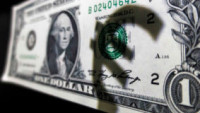 Weak Chinese trade figures affected the market’s risk sentiment, though the negative effect was less because of the seasonal effects: Lunar New Year holidays reduced the nation’s trade activity in February.
Weak Chinese trade figures affected the market’s risk sentiment, though the negative effect was less because of the seasonal effects: Lunar New Year holidays reduced the nation’s trade activity in February.
Another positive factor is the continuing advance of oil prices. Brent rose above $41 a barrel. Data showed that China’s oil imports rose by 24.5% in February on the annual basis. The weekly data by the EIA will be released Wednesday. Kuwait’s oil minister said that his country will participate in an output freeze if all major oil producers, including Iran, agree to do the same.
EUR/USD approached resistance at 1.1050 (200-day MA). A close above here is needed to allow growth to 1.1100 and 1.1165. The single currency was supported by the market’s cautious sentiment. In addition, German industrial production added 3.3%. Support is at 1.0980 and 1.0960 ahead of 1.0900.
GBP/USD decline from the 1.4250 (50% Fibo of February decline) to 1.4200 area. The Bank of England announced that it has measures in place in order to diminish negative impact on the UK financial system in case of Brexit. Britain will release manufacturing production at 09:30 GMT. There’s downtrend resistance line in the 1.4300 zone. Next resistance is at 1.4350. Support is at 1.4150/00.
USD/JPY slid to 112.75. Japan’s Q4 15 GDP was revised from -1.4% to -1.1% on the annualized basis. The pair is expected to remain in a narrow sideways range with support at 112.50 and 112.15 and resistance at 113.25/50.
AUD/USD found support around 0.7400. The next revel to watch on the upside is 0.7530. Support is at 0.7380. For gold (XAU/USD) resistance is at $1280, while support is at $1260.
Support for USD/CAD is at 1.3287 (200-day MA) and 1.3230 (uptrend support line). The loss of these levels will make the pair vulnerable for a decline to 1.3000. Firstly, however, correction up to 1.3455 is likely. The Bank of Canada is not expected to change its policy (15:00 GMT) as the government plans fiscal stimulus.
Origin: FX BAZOOKA












